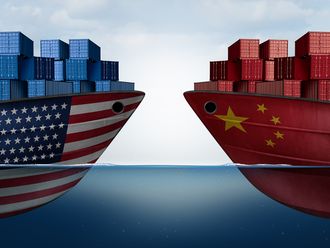Do oil exporters need to have their currencies pegged to the US dollar? My previous article mentioned how the dollar replaced gold as the world’s currency, or as a main reference point for all trade transactions.
Price of oil has always been quoted in US dollars, which is one reason used to justify pegging the currencies of oil exporting countries to the dollar. Putting this differently: non-US oil exporters are selling oil to countries other than the US with the prices being always quoted in dollars. Why?
Now the importance of this is in what comes naturally associated with a peg to the dollar, one of which is that you must sync your monetary policy with that of the US — Saudi Arabia, the UAE, Kuwait, Bahrain, and Qatar have just raised interest rates following the Fed’s decision to do so.
This is important for two reasons: 1. The Fed is planning additional hikes in 2017, which will result in the same GCC central banks hiking rates as well. The immediate consequence of that would be more restrained private consumption by having less lending and borrowing transactions. 2. Low oil prices are restraining governments’ spending, which further amplifies ramifications of the first reason.
So, is the peg necessary?
The history of currencies in the Gulf is quite complex, with the reliance on Indian currencies at times and developing their own currencies at a future time. And so it is understandable that pegging currencies to the US dollar is the way forward, especially when you look to countries to your East and to your West having their currencies pegged to it.
The question here is not about unpegging as the US dollar will continue to play a major role in the world’s economy, despite the increasing role of other countries in global trade transactions. But to ask the right question here, one must first note that what would be good for GCC countries is more monetary flexibility.
That mainly means being able to determine their own interest rates and hence the values of their currencies. Keep in mind here that countries pay up to back currency pegs when there are increasing pressures on a value depreciation.
This is why we hike rates when the Fed hikes rates. Such conditions, however, are not favourable with low oil prices.
So, how to achieve more monetary flexibility? In all cases, a currency being pegged to a single currency would always carry its risks.
The Asian currency crisis is one clear example of that. In an ideal scenario, a country will peg its currency to currencies that dominate its trade transactions, these including the origins of its imports and where its exports go.
As for oil, and besides the US, top 10 importers include Singapore. The reason I mentioned Singapore here is that, although it ranks eighth in top 10 oil importers, the Singaporean dollar is not pegged to the US dollar. Instead, Singapore has its dollar pegged to an “undisclosed basket of currencies”, one that reflects its “trade links”.
So why not for GCC countries? Given that they are aiming to diversify away from oil and to expand their free trade agreements. Not only that, it would be safe to assume that countries around the region would eventually become major trading partners of the GCC.
I have mentioned in a previous article that unpegging from the dollar would affirm a country’s directions towards less reliance on oil. It is also part of a country’s move from developing to developed status, with a more independent monetary policy giving the country plenty of room to decide what best works for its economy as a whole.
The last question that I want to leave you with: when the US becomes oil independent, how important will the peg to its dollar be?
The writer is a UAE-based economist.












